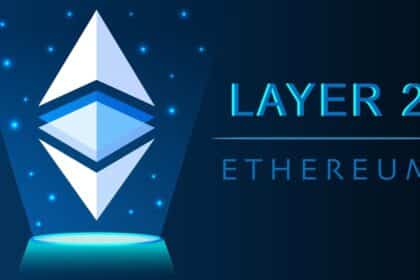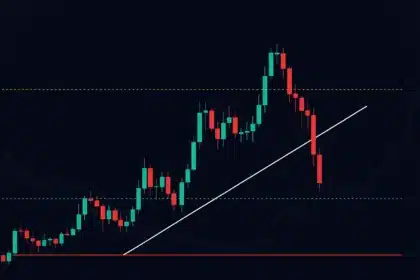Ethereum co-founder Vitalik Buterin has introduced a new upgrade proposal that aims to make it substantially easier for users to run Ethereum nodes without relying on advanced hardware or centralized infrastructure. The initiative, outlined in a blog post on Ethereum’s research forum, recommends shifting away from full network data replication toward a more personalized and efficient model.
The proposed Ethereum upgrade comes as the network’s global state exceeds 1.3 terabytes, creating barriers for average users to operate fully verified nodes. By moving to a local-first architecture, the Ethereum upgrade would allow individual nodes to store only the data relevant to their activities, greatly reducing local storage demands.
“Currently, the overhead is impractically high. Most users cannot run full nodes without specialized setups or cloud assistance.” Buterin emphasized the importance of this transition.
With this Ethereum upgrade, Ethereum aims to bring node operation within reach of standard consumer devices including smartphones, thereby reinforcing its decentralization goals.
A Local-First Approach to Node Storage
At the heart of the proposed Ethereum upgrade is a local-first approach, where nodes prioritize syncing data relevant to a user’s specific needs. Instead of managing Ethereum’s full historical ledger, nodes would fetch additional data on-demand, similar to inter-library book requests.
This decentralized, modular method could resolve several structural challenges facing Ethereum. By cutting down on bandwidth and storage pressure, the Ethereum upgrade offers a compelling path toward a more inclusive and censorship-resistant blockchain ecosystem.
Buterin believes that allowing more users to operate lightweight, self-verified nodes is essential to Ethereum’s long-term vision.
“The less we depend on large third-party providers, the more secure and resilient the network becomes,” he stated.
The Ethereum upgrade would not only reduce reliance on centralized services but also eliminate some of the core friction points preventing average users from participating directly in the Ethereum network.

Coming Ethereum Upgrade Aligns with Pectra and EIP-9698
This proposal coincides with Ethereum’s Pectra upgrade, one of the network’s most ambitious overhauls to date. The Pectra Ethereum upgrade paves the way for enhanced scalability and performance. It is to be a foundational step toward the integration of new consensus features and optimized data handling.
Simultaneously, Ethereum Foundation researcher Dankrad Feist recently introduced EIP-9698, a proposal to raise the gas limit by 100 times over the next two years. This complementary Ethereum upgrade could dramatically boost Ethereum’s transaction throughput to over 2,000 TPS, positioning the network for mainstream scalability.
Together, these upgrades including Buterin’s decentralization-focused model show a clear shift in Ethereum’s trajectory. By combining performance improvements with broader accessibility, the Ethereum upgrade strategy aims to balance scalability with decentralization.
Ethereum’s Role in Fixing AI’s Centralization Problem
Beyond node infrastructure, the broader Ethereum community is discussing how the upcoming Ethereum upgrade could also intersect with artificial intelligence (AI). Former Ethereum core developer Eric Connor recently stated that Ethereum is uniquely positioned to tackle AI’s growing centralization problem.
“AI is plagued by black-box models, centralized data silos, and privacy pitfalls,” Connor said.
This statement suggests that a decentralized network like Ethereum particularly post-upgrade could offer an open, transparent framework for AI development and deployment.
The next Ethereum upgrade could integrate protocols that reinforce user privacy, data ownership, and model accountability. As AI becomes more embedded in daily life, the potential overlap between blockchain infrastructure and AI governance becomes increasingly relevant. The Ethereum upgrade may become a critical piece in that puzzle.
Internal Criticism and the Future of Ethereum Upgrades
Despite widespread support for Buterin’s vision, not all stakeholders agree on Ethereum’s current direction. Crypto venture capitalist Nic Carter recently voiced concerns over Ethereum’s evolution, citing the rise of layer-2 networks and unchecked token issuance as key issues. He argued that many L2s contribute little value to Ethereum’s base layer, instead draining economic activity from it. Carter also criticized excessive token creation, stating,
“ETH was buried in an avalanche of its own tokens. Died by its own hand.”
Such internal critiques point to a debate on how future Ethereum upgrades should be prioritized between scalability, decentralization, and monetary policy integrity.
Nonetheless, Buterin’s newly proposed Ethereum upgrade stands apart for its direct focus on user accessibility and infrastructure resilience. By lowering the technical bar for running nodes, Ethereum takes a proactive step toward inclusive decentralization.

Conclusion: A Bold Step Forward for Decentralized Access
Vitalik Buterin’s latest Ethereum upgrade proposal addresses the long-standing challenge of making full node operation viable for everyday users not just institutions or miners. By embracing a local-first architecture and preparing for wider protocol enhancements, Ethereum is moving closer to its foundational ethos of open, equitable, and censorship-resistant access.
The success of this Ethereum upgrade could redefine what it means to participate in the blockchain economy. From improved decentralization to stronger user privacy and AI integration, the next chapter in Ethereum’s journey is shaping up to be both technically bold and philosophically aligned with its founding principles.
Follow us on Twitter and LinkedIn, and join our Telegram channel.
FAQs
What is the purpose of the new Ethereum upgrade?
The main goal is to reduce hardware and storage requirements for running Ethereum nodes, making participation accessible to more users.
How does the Ethereum upgrade improve decentralization?
By allowing users to store only relevant data locally, it reduces reliance on centralized node operators and cloud infrastructure.
How does this upgrade relate to AI?
The upgrade could support decentralized AI applications by reinforcing data privacy and network transparency.
Will Ethereum continue to issue new tokens?
Token issuance remains a point of debate within the community, but this specific Ethereum upgrade focuses on infrastructure, not monetary policy.
Glossary
Ethereum Upgrade: A planned protocol change or enhancement to the Ethereum blockchain that affects performance, scalability, or usability.
Node: A computer that participates in validating and relaying transactions on the blockchain.
Gas Limit: The maximum amount of computational effort that transactions on the Ethereum network can use in a block.
Local-First Architecture: A design principle where systems prioritize local user data and request additional data as needed, improving efficiency.
Layer-2 (L2) Network: A secondary framework built on top of Ethereum to process transactions more efficiently.





























